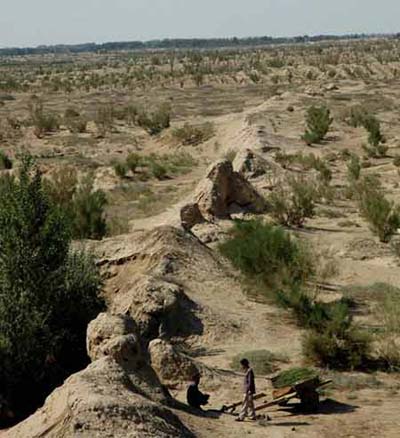| Home / Environment / News | Tools: Save | Print | E-mail | Most Read |
| Sandstorms Devouring Great Wall in NW China |
| Adjust font size: |
Sand storms in northwest China's Gansu Province are reducing sections of Great Wall to mounds of dirt and may cause them to disappear in about 20 years, archaeological experts say. Zhou Shengrui, former curator of the Minqin County museum, said a national survey in the 1980s recorded more than 60 kilometers of Great Wall in the county, but they were rapidly disappearing.
The part of Great Wall, built in the Han Dynasty (206 B.C.- 220 A.D.) and extended in the Ming Dynasty (1368-1644), is on the main trunk of the Wall, which runs from the Shanhaiguan Pass in north China's Hebei Province westward to Gansu's Jiayuguan Pass, about 500 kilometers west of Minqin. "This section of Great Wall was made of mud rather than brick and stone and is more prone to erosion. Over time, the wall has become brittle and the mud has been sanded down and blown away," Zhou said. "Similar erosion happened to the Great Wall in other places, but the situation is much more worse here," he added. Extensive farming since the 1950s sapped underground water in Minqin and destroyed the local ecology. The 400-sq-km, 60-meter-deep Qingtu Lake dried up in the 30 years since the 1960s, and by the early 1990s, the lake had been smothered by creeping yellow sand and become part of the Badain Jaran Desert, which spans more than 40,000 square kilometers. Minqin has since then become a major source of sand storms in northwestern China. "Frequent storms not only eroded the mud, but also cracked the Wall and caused it to collapse or break down," Zhou said. More than 40 kilometers of the Wall have disappeared in the past 20 years, and only about ten kilometers remain. Its height has been reduced from five meters to less than two meters. Square lookout towers have disappeared completely. Wei Zhaobai, 61, a resident in Chengxi Village, Daba Township of Minqin, said, "The Great Wall gets shorter every year. "When I was seven or eight years old, the section of Great Wall about 1,000 meters west of my village was still as new. We used to walk on it like the ancient soldiers," Wei said. "As a relics protector, it saddens me to see the Great Wall being blown away, but we hope it can be a warning of what we have done to ourselves and our environment," Zhou said. He said unless the local vegetation recovered and the sand storms contained, the damage was irreversible. Local workers were covering the wall remains with more sand and dirt. ?"If sand storms strike again, it will take some time to blow the top-dirt away, and that'll give us time to build barriers and plant trees," Zhou said, adding that there is no other way for the time being. (Xinhua News Agency August 30, 2007) |
| Tools: Save | Print | E-mail | Most Read |
 |
| Related Stories |
|
|||

